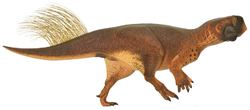| Chaoyangsauridae Temporal range: Late Jurassic, | |
|---|---|
 | |
| Compared close-up of the four so far known chaoyangsaurid genera, with pink representing known parts of skulls | |
| Scientific classification | |
| Kingdom: | Animalia |
| Phylum: | Chordata |
| Class: | Reptilia |
| Clade: | Dinosauria |
| Clade: | † Ornithischia |
| Clade: | † Ceratopsia |
| Family: | † Chaoyangsauridae Zhao, Cheng, & Xu, 1999 |
| Type species | |
| † Chaoyangsaurus youngi Zhao, Cheng, & Xu, 1999 | |
| Genera | |
Chaoyangsauridae is a family of ceratopsian dinosaurs. They are among the earliest known marginocephalian dinosaurs, with remains dating to about 160 million years ago, during the Late Jurassic period. Members of this group had sharp beaks for snipping off leaves to eat, and a very small frill.
This family is officially defined in the PhyloCode as "the largest clade containing Chaoyangosaurus youngi , but not Psittacosaurus mongoliensis and Triceratops horridus ". [1]
Four dinosaur genera, Chaoyangsaurus , Xuanhuaceratops , Yinlong and Hualianceratops , are usually considered to belong to the Chaoyangsauridae. [2] [3] [4] In 2020, Yu et al. classified Stenopelix as a chaoyangsaurid. [5]




